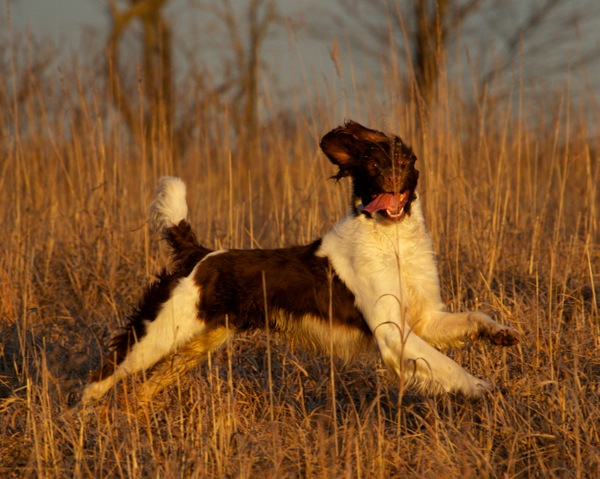
Name: Pinecroft Taylor’s Big Boy, “XL”
Breed: English Springer Spaniel (field-bred)
DOB: 8/3/2009
Owner: Admin
Tuesday, 1/29/2013:
We had a very unseasonably warm day for Wisconsin with very cold weather to follow shortly, so I took my dogs for a walk before heading to the office. I noticed as we were returning to the kennel that XL was lagging the group as I turned them into the yard. When he trotted up to me – a bit of a tell in itself, he’s almost always running – I thought his breathing sounded ragged. I took him back to the kennel, gave him some time, and then checked his temperature. VERY elevated. I got out the stethoscope I bought a few years ago, but still haven’t developed any expertise with, and tried listening to XL’s lungs. I heard a “whooshing” noise. I went around the kennel trying it on several of the other dogs to make a comparison, and I didn’t hear much of anything. I kept going back to XL, and kept hearing the “whoosh.” I figured enough time had passed for him to cool down and took his temperature again – still over 104. Refill rate and gum color were fine, and he was still interested in taking a dog biscuit, but I decided to take him to the vet since he’s entered in our first field trial for 2013 in Tennessee next week.
I was able to get an appointment at the clinic right away. His temperature in the exam room was 102.9. Our vet didn’t hear anything that troubled him with his stethoscope, and we were about to chalk it up to over-caution on my part but decided to take a chest x-ray just to be thorough. Yet another reminder – more often than not, it’s best to trust your “owner’s intuition.” Our vet walked back into the exam room looking a bit surprised, and showed me his laptop screen saying “there’s fluid in his chest.” We had a set of “clean” films to compare to that were taken when XL was diagnosed with Lyme disease in October, 2011.
My vet and I agreed that I would start him on clindamycin right away. He noted that they have been seeing some cases of blastomycosis recently, so they extracted a urine sample for that test. I took him back to the office and we finished out my work day uneventfully. He was happy to have his dinner that night. He was a bit subdued, and his temperature was 103.5, so still cause for concern.
Wednesday, 1/30/2013:
XL seemed okay Wednesday morning. I took him back to the office with me, where he slept more than he might usually – I often refer to him as “Dennis the Menace with fur,” and he gets into EVERYTHING – but was reasonably bright. He seemed to be benefiting from the antibiotic therapy, so I was not surprised when my vet called to report that the blasto test was negative. He ate well again when we got home, but his temperature was 103.7. At 11:30, he was standing with his tail tucked and his back roached, a bit glassy-eyed. I brought him to the house to make sure he’d be warm enough overnight since we keep the kennel at 53 degrees, and to monitor him more closely. Neither of us got a lot of sleep. Several times he sat up and extended his head as far forward as possible, straining to get enough air. I put my hands on his sides, and barely felt his ribcage move.
A week earlier, I had found XL in similar distress when I did my late night chores. His abdomen felt very rigid and somewhat full, his temperature was 102.9. XL has an unfortunate fondness for raiding the trash cans now and then, and I was concerned that he was trying to bloat. I was worried enough to call the emergency service for our vet clinic. When one of the vets called me back and we discussed his symptoms, we ruled out bloat as a serious concern because he hadn’t vomited, and didn’t seem to be trying to. It was another VERY cold night, so I brought him in the house and crated him, and slept nearby with one ear open to monitor him. By morning he had perked up and all systems seemed to be working, so I chalked up his symptoms to eating something he shouldn’t and giving himself a bellyache. Now I know that more likely he was in pain, but he seemed normal enough for the rest of the week. He trained well Saturday (1/26), in hindsight almost too well-behaved for him.
Thursday, 1/31/2013:
I called my vet first thing, and we agreed that it would be best to take XL directly to the University. He was admitted promptly as an emergency case. To my tremendous relief, after a student took his case history and took XL for an ultrasound, when a vet came in to speak with me, there wasn’t any chatter about ruling out cancer, etc. I was trying to count on my way to Madison, and XL is at least the fifth dog we’ve taken to UWM for treatment, we’ve otherwise only taken dogs there for eye exams (and would be happy to keep it that way). All have been for grass awn infection, and three were treated twice (Tai, Sail, & Roz).
No surprise, the ultrasound showed fluid on both sides of XL’s chest cavity. Dr. Walker and I agreed on a preliminary course of treatment – obtaining a fluid sample for cytology, blood work, more x-rays if needed, and chest drains. Dr. Walker suggested a newer, smaller-diameter version of drain that could be inserted with sedation.
Dr. Walker called in the afternoon to report that XL’s bloodwork was normal other than one value that reflected inflammation. The fluid sample showed several forms of bacteria; cultures were submitted. XL was started on IV antibiotics (more details will be available with his discharge report, which I will post as soon as I have it). XL was scheduled for a CT scan the next morning. At that point it seemed more prudent to wait to insert the chest drains until after the scan, since he would already be anesthetized. We would use the “older” style of drain, since the larger diameter would make lavage easier. I expressed concern that XL’s symptoms seemed to worsen at night, and Dr. Walker told me that she would add some pain medication to make sure that XL stayed comfortable.
Friday, 2/1/2013:
Dr. Walker called this morning about 8:30 to assure me that XL had a reasonably comfortable night, and that his temperature had come down somewhat. Nice to hear that the antibiotic therapy seemed to be working. She said that his CT scan would be done between 9 and 10, and that she’d call me once she knew the results so that we could decide how best to proceed.
The CT scan showed fluid in the thorax, as we expected, and some areas of gas, but nothing that suggested the presence of an abscess. We decided that medical management remained the best course of treatment. About 15 minutes later, though, Dr. Walker called back to say that on more thorough inspection, the radiologist had noticed a pocket at the back of the lung, against the chest wall. The CT couldn’t visualize that area very well, it might or might not contain plant material. She had conferred with a surgeon, who felt that he could access that area through the chest (a thorocotomy), but the surgeon was not necessarily advocating for surgery at this time. I had to make a quick decision – if we were going to opt for surgery, they would proceed while he was anesthetized. This was agonizing. Grass awns will typically migrate up, toward the spine, and surgery there can be difficult to impossible. I would hate to miss a viable opportunity to remove plant material while it was pinned down, but I decided that I could not justify an invasive procedure without more evidence that plant material was present.
We agreed to proceed with our plan to set the chest drains and continue the antibiotic therapy. By early afternoon, about 250 ml (approximately one cup) of fluid had drained. Dr. Walker feels that’s not a huge amount, but it’s substantial enough given that in some cases, practically no fluid will drain. They are monitoring the drainage to catch any plant material in the exudate. Dr. Walker mentioned that XL was well-behaved, liked having someone sit in his crate with him, and that he seemed to have figured out how to encourage the students to keep him company. That’s my boy . . .
Evening report (Dr. Walker works LONG days) – the first lavage this afternoon was about 200 ml per tube, and about the same amount was “returned.” He was scheduled for another lavage in about an hour. He seemed comfortable enough, given the circumstances. I plan to go visit him tomorrow afternoon.
Saturday, 2/2/2013
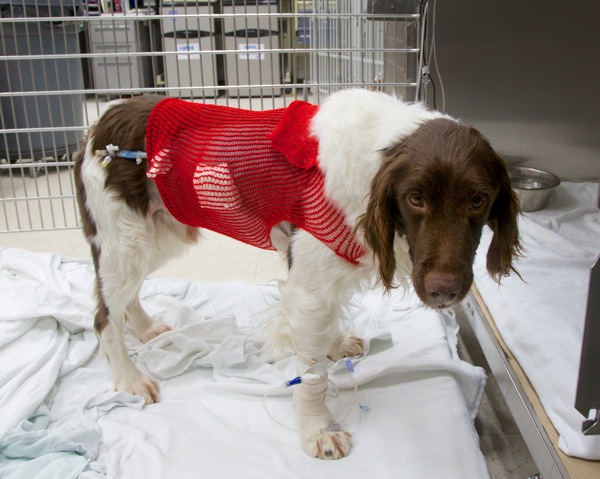
I visited XL at UWM this afternoon. He’s getting great care from very dedicated staff there. He’s had issues today with nausea, and he wasn’t feeling very well. He’s not eating. I went outside with him with his vet tech – I think the little walk was good for him – and he peed for the first time since last night. That should have made him feel good, he’s getting plenty of fluids so he peed about a gallon, and his urine was very yellow/concentrated. He also pooped, which was also good. He’s having some small bowel diarrhea, but not terribly so, this is normal after anesthesia.
XL stood most of the time I was there. The tech said that human patients report that chest tubes are uncomfortable. Not painful, just uncomfortable, and between that and the nausea, XL seemed pretty out of it. He has tubes as shown in the photo above on both sides, so I think it’s partly a matter of him now knowing how to find a comfortable position to sleep. I know he knew I was there, and he’s not the most demonstrative dog anyway, but he didn’t react strongly to my presence. He heeled with me when we went outside, and he did try to follow me out when I left, though, which of course made me feel that much more terrible.
He finally sort of collapsed into my lap and went soundly to sleep. Unfortunately after about a half hour it was time for his lavage treatment, so we had to wake him up. The saline solution inserted through his tube is clear, but the aspirated fluid was the color of pink lemonade and cloudy, and contained some small strings of clotted blood. Apparently this is his body attempting to deal with the inflammation. It would be a sign of improvement for the drainage/aspirate to be clearer. They plan not to continue the lavage tomorrow to see how his body is doing.
He’s also producing some air through the chest drain. This could be from several causes, including the migration out of plant material, but regardless suggests an injury or trauma to the lung.
His temperature today has actually been slightly below normal. That can happen with the fentanyl.
About a half hour before I left, XL was given a second medication for nausea. I hope that this makes him more comfortable through the night. The tech said that he had slept soundly for about 4 1/2 hours this morning, so it’s not that he’s entirely unable to rest. I hope that he was able to get more good sleep after I left him.
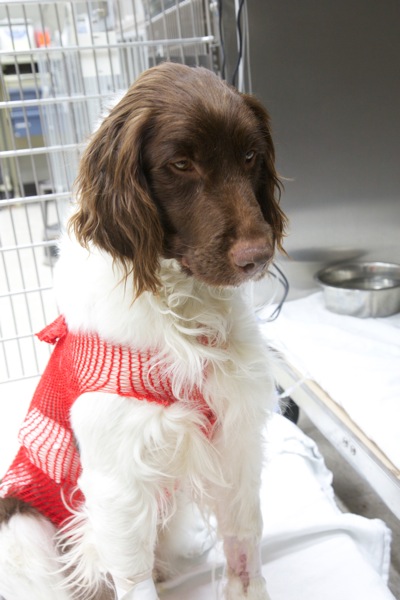
I’m trying to remind myself that he’s recovering from a significant procedure just yesterday, so I may be expecting too much, too quickly, but it’s so hard to see him feeling so droopy :-( . He actually looks better in the photo above than he was.
Sunday, 2/3/2013:
10 a.m. – Dr. Walker just called with an update. It sounds like the second anti-nausea medication helped XL rest better last night. Dr. Leonard, who covered the night shift, sent Dr. Walker some photos. His eyes look clearer here than yesterday afternoon:
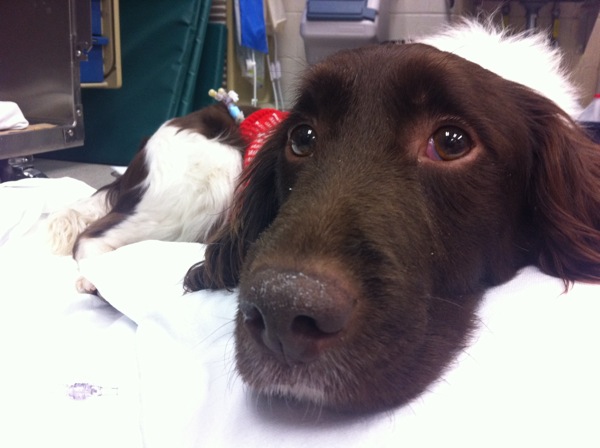
He’s getting down into a sleeping position on his own more easily and getting some rest. That’s a very good thing:
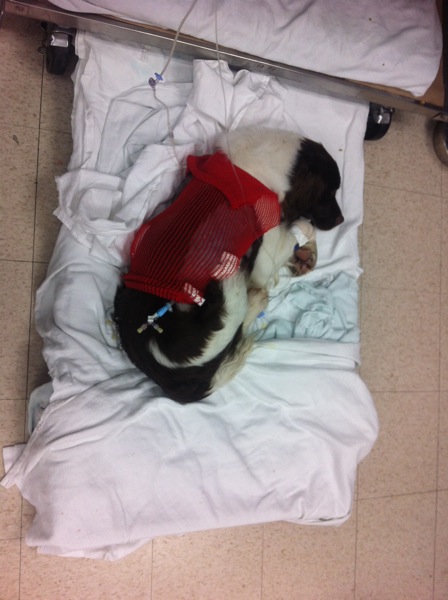
He is producing less air through the drain tube, which is a positive. Unfortunately the fluid color hasn’t lightened significantly. Some culture results should be available tomorrow early afternoon, so we’ll know if adjustments in his antibiotics could be needed. They will probably lavage once today after all, trying to flush the bad stuff (that’s my technical term) out.
5:00 p.m. – Yay, good news!!! XL rested well through the day, the air and fluid drainage from his tubes decreased and the fluid color has lightened somewhat, and he felt well enough to eat something :-) . Less good news, he’s still having stomach issues and vomited at least some of the food back up. Adjusting medications to try to help him with that. SO grateful for some indications of forward progress.
Monday, 2/4/2013:
9:15 a.m. Morning report continues to be positive overall. XL is “more present,” and showing some appetite and desire to move around. He’s been given omeprazole to protect his esophagus and stomach, and metoclopramide to encourage better gut motility. It’s normal with the pain medications he’s received and his inactivity to see some slowdown in the gut.
Fluid production from his chest tubes is now negligible, 8 cc on his left side, 2 on the right, with no air. Unfortunately the drainage is still cloudy with color. The fluid has been sent to the lab for analysis and comparison to what was recovered last Thursday. XL will have chest x-rays today too, and his preliminary culture results should be available midday. Once we have all of this information to consider, we will discuss the best plan for proceeding. If there still seems to be one or more pockets of infection that aren’t clearing with the tubes and antibiotics, surgical debridement may still be required to resolve the infection.
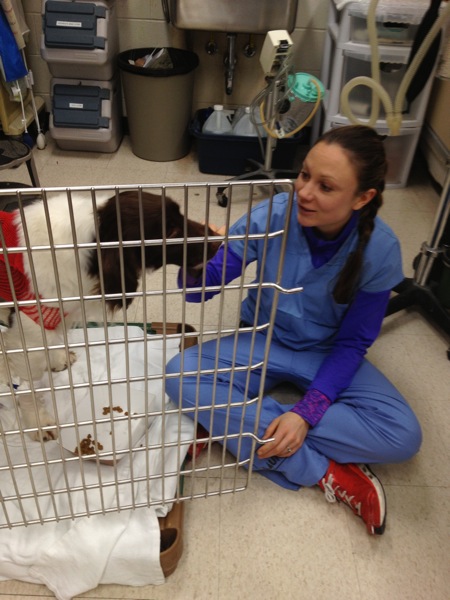
Morning photo with XL’s friend Mandy, who’s been taking EXCELLENT care of him in CCU. He ate several biscuits and some Performance this morning. And look – he’s smiling :-) !!
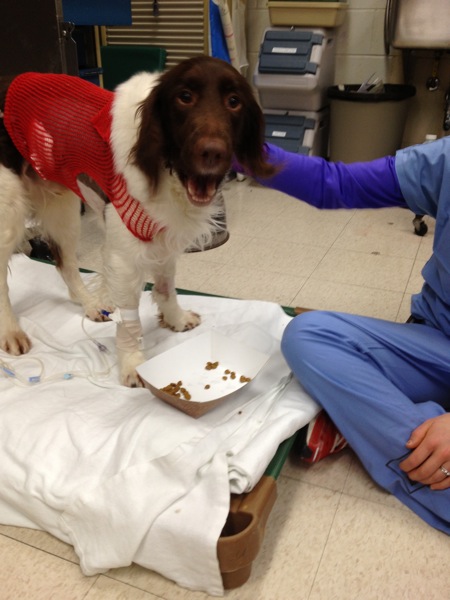
3:00 p.m. – XL’s chest x-rays looked pretty good. Analysis of the drainage fluid showed a 50% reduction in neutrophils compared to last Friday. Culture showed pasteurella. That’s not unusual, this is picked up in the mouth as the plant material comes in. This should be covered by his present antibiotics (essentially clavamox and Baytril). Nothing anaerobic showing up yet, and it might not. Those buggers are typically elusive to culture, and him having been on antibiotics for two days before admission may have already reduced the population. Taking all of this into account, Dr. Walker and I agreed that the best course of action is to not proceed to surgical debridement at this time. She was going to do one more lavage today, and then remove one of his chest drains since she’s been seeing transfer from one side of his chest to the other anyway. If he continues to do well, he may be ready to come home tomorrow evening, otherwise we’d hope for Wednesday morning.
9:30 p.m. – Dr. Brian Leonard (who took the photos above on 2/3; thanks again!) reports that XL continues to do well. His right chest tube was removed this afternoon. They are transitioning him to oral pain medication. His appetite continues to be good. Sounds like XL has made some good friends during his stay :-) . Dr. Leonard thinks he has very big feet!
Tuesday, 2/5/2013:
9:00 a.m. Very good report from Dr. Walker this morning. She said XL is that much brighter, and wagging his tail more. His temperature is normal and his appetite remains good. She did get more air from the remaining chest tube after removing the right one yesterday. Minimal fluid drainage. She’s going to keep an eye on him and make a decision later today as to whether to remove the left tube. Full culture results should be available later today as well. It’s possible that he might have been able to come home this evening, but we agreed that due to some personal considerations, it will be best for XL to stay a few extra days, so that means no pressure to rush to remove the second chest tube.
5:15 p.m. XL’s friend Mel called to give me an update. XL continues to feel better. He was starting to chew on his remaining chest tube, and since there was very little drainage today, it was removed. He’s now on oral antibiotic. Final culture results did not show anything in addition to the pasteurella from the preliminary report.

5 Responses to Case History – XL 2013 Pyothorax